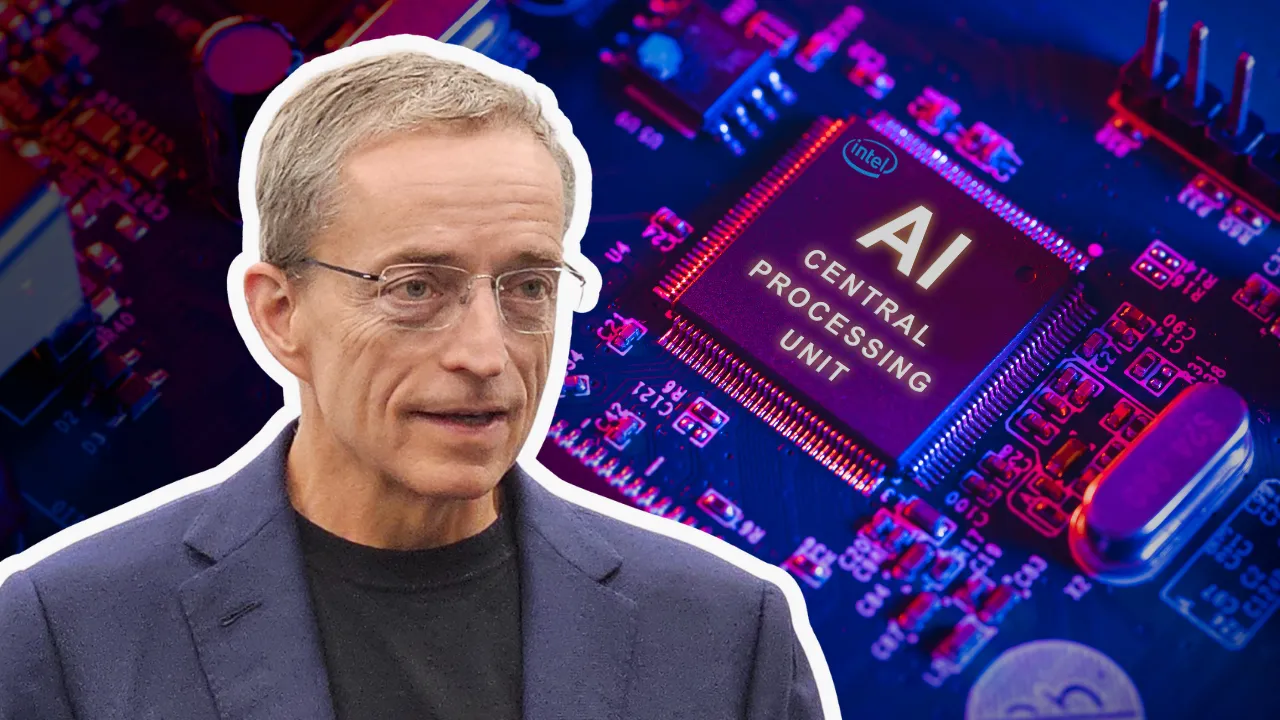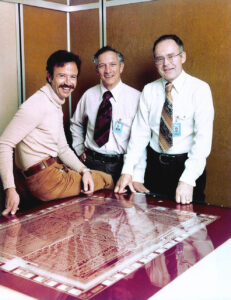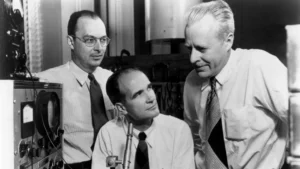Introduction
In the dynamic landscape of the semiconductor industry, few leaders possess the unique blend of technical prowess and strategic vision that defines Patrick Paul Gelsinger, the current CEO of Intel. Pat Gelsinger has embarked on a mission to revitalize the iconic company.
Since he became the CEO in 2021, he has taken a lot of risks and has launched initiatives which try to dethrone TSMC From fab, Nvidia from AI load and AMD from Data centre…all at the same time.
IDM 2.0 consists of three main components: Internal Foundry Network: Intel will continue to build the majority of its products in its factories. Third-Party Foundry Capacity: Intel will digitally expand its use of third-party foundry capacity to optimise product roadmaps.
In last 3 years, Intel is becoming what it used to be pre-2010. The surety of success is still uncertain the CEO has faith he can fix it all. In this article we bring you Gelsinger’s journey from Intel to being back at Intel. A saga that spans 40 years!

Follow us on Linkedin for everything around Semiconductors & AI
A snapshot of his journey at before, during and around intel
1961
Gelsinger is born in rural Robesonia, Pennsylvania. “Our family raised dairy cows, pigs, soybeans and sorghum,” he told Forbes in 2016.
1979
At 18, Gelsinger receives his associate degree from Lincoln Technical Institute and moves to Silicon Valley to start his career at Intel as a quality control technician.
Read More: Hotel Administration to Billion Dollar Company: Story of Qualcomm
1983
While at Intel, Gelsinger graduates with a bachelor’s degree in electrical engineering from Santa Clara University.
1985
Intel introduces the 386 microprocessor. Gelsinger is design engineer No. 4 on the 386 processor design team.

Additionally,that same year, Gelsinger graduates from Stanford University with a master’s degree in electrical engineering and computer science.
1988 –Gelsinger earns his first of eight patents
1989-Intel launches the 486 processor. 1989 The Intel 80486, also known as the 486.
“The 486 was my baby, from the beginning, to finishing it, bringing it into production.
I remember the feeling I had when I saw the first 486 ads hit, and the first 486 ads from our customers.”
1992-Gelsinger becomes vice president of the Intel Products Group and general manager of the Personal Computer Enhancement Division in the Business Communications Division.
1996-
He takes the role of general manager of Intel’s Desktop Products Group.
2001-
Gelsinger is named Intel’s first chief technology officer.
2005-He becomes senior vice president and general manager of the Digital Enterprise Group.
“My last role was this period of the multi-core transition where AMD had leapt ahead of us with Opteron. Not only did we come back, but we set up 10 years of thriving in the data centre. That’s what great companies do.”
2009-Gelsinger leaves Intel to join Dell EM
2012-
Gelsinger is named CEO of VMWare. In 2019, Glassdoor ranks him the best CEO in America.
2021-Gelsinger is named CEO of Intel.
“To come back ‘home’ to Intel in the role of CEO during what is such a critical time for innovation, as we see the digitization of everything accelerating, will be the greatest honour of my career.”
Early Roots in Rural Pennsylvania
Gelsinger begins his journey in Pennsylvania, growing up on family farms within an Amish and Mennonite community—two Christian groups that share origins in medieval Europe. Probably a reason why you though Gelsinger does appeal American xD.
This humble beginning laid the foundation for a future marked by innovation and leadership. His early aptitude for electronics was evident when, as a teenager, he scored exceptionally well on a Lincoln Tech electronics technology test, earning an early-admission scholarship.
Skipping his final year of high school, Gelsinger embarked on a journey that would take him to Silicon Valley at the tender age of 16. Working at WFMZ-TV Channel 69 as a technician while pursuing an associate’s degree from Lincoln Tech, he quickly caught the attention of the tech giant, Intel.
Read More: How Intel PC Dominance is Threatened by Qualcomm Snapdragon Elite
The Intel Odyssey
In 1979, at the age of 18, Gelsinger joined Intel as a quality-control technician. This marked the beginning of a remarkable career that spanned over three decades. He demonstrated a commitment to learning and growth during his early years at Intel, earning him a reputation for dedication and excellence.
Gelsinger’s ascent within Intel was rapid. By the age of 32, he achieved the distinction of being the youngest vice president in the company’s history.
His technical acumen shone brightly as he played a pivotal role in the development of the 80486 microprocessor (also known as intel 486), earning him the title of the lead architect of the 4th generation 80486 processor introduced in 1989.
Mentored by Intel CEO Andrew Grove, Gelsinger’s influence extended to key technological developments, including Wi-Fi, USB, and the groundbreaking Intel Core and Intel Xeon processors. His leadership was instrumental in the success of 14 chip projects and the launch of the Intel Developer Forum conference, a significant counterpart to Microsoft’s WinHEC.
“Andy was a personal mentor and friend for 35 years,” said Gelsinger on stage during The Channel Company’s 2018 Best of Breed conference.
Gelsinger Rumoured to Head Intel Multiple Times
Throughout the 2010s, rumors circulated multiple times suggesting that Gelsinger would assume the role of Intel’s next CEO, given his extensive history with the company.
Prior to joining EMC in 2009, Gelsinger led Intel’s Digital Enterprise Group that accounted for more than half of Intel’s annual revenue and was responsible for the company’s enterprise products including PCs, servers, communications and storage.
In 2013, many widely expected that Gelsinger would succeed former Intel CEO Paul Otellini.That didn’t occur. A disagreement about the company’s future direction led to Gelsinger’s departure from Intel.
Then in 2018, it was rumoured that Gelsinger could replace Intel CEO Brian Krzanich, who had abruptly resigned from the company. Gelsinger needed to go on Twitter to dispel the rumour that he was leaving VMware after several media outlets said Intel should pursue him.
“Thanks for the shout out, but I love being CEO and not going anywhere else. The future is software!!!” said Gelsinger in 2018.
VMware and Seasoned Leadership
In 2012, Gelsinger assumed the role of CEO at VMware, where he honed his leadership skills and navigated the complexities of a rapidly evolving tech landscape.Additionally, His tenure at VMware marked a period of growth and innovation for the company, earning him the moniker of a “seasoned CEO.”
The Homecoming & Intel’s Renaissance under his leadership
Upon his return as Intel’s CEO in February 2021, Pat Gelsinger inherited a company grappling with mismanagement and facing intense competition. Intel had fallen behind in process-node development compared to TSMC, with struggles at 10nm while TSMC was already at 7nm. AMD had surpassed Intel in client and server performance, steadily gaining market share, while Nvidia continued its dominance in the GPU market and AI processing.
Compounded by missed deadlines, notably for the Sapphire Rapids Xeon processor overhaul scheduled for 2021, Intel also experienced talent losses such as Renee James and Jim Keller. Seeking to reclaim Intel’s semiconductor leadership, Gelsinger outlined ambitious plans for fabrication upgrades and set an aggressive timeline to revitalize the company’s chip roadmap.
“We need to boldly seize this moment.” – Gelsinger
Gelsinger wasted no time in setting a course correction for Intel. Moreover,his strategic vision included the construction of two $20 billion manufacturing plants in Arizona, signalling a commitment to expansion and technological advancement.
Gelsinger’s influence on Intel’s trajectory has been profound. He demonstrated his commitment to addressing the global chip shortage when President Joe Biden appointed him to the Council of Advisors on Science and Technology in 2021. Additionally, Gelsinger’s expertise positioned him as a key advisor on critical issues, including the passage of the CHIPS Act.
“We as an industry are all navigating through one of the most complicated macro environments ever. We are balancing shifts in the world order, shifts in economic and social theory, managing out of a global pandemic, all while also planning for the future.”
~Pat Gelsinger, CEO, Intel
The CEO underscored his dedication to innovation and expansion by announcing a substantial three-and-a-half-billion-dollar upgrade to Intel’s fab in New Mexico.
The “Fab” Turnaround
Gelsinger has directed substantial investments into Intel’s fab business, concurrently making decisive cuts in non-profitable areas. He has discontinued various product lines, notably Optane persistent memory. Additionally, Gelsinger oversaw the sale of the McAfee security division, the Intel drone business, NAND flash products, RealSense visual sensors, and Intel Sports (though this process began prior to Gelsinger’s arrival).
Opinions on the decision to discontinue Optane vary, with some expressing mixed feelings about its importance. O’Donnell acknowledges potential long-term repercussions but believes it is the right move in the short term to refocus on core capabilities. Newman supports the idea of shedding non-core business lines during a reorganization period, emphasizing the importance of prioritizing essential areas.
Gelsinger has also shifted spending priorities, particularly in curbing stock buybacks. Acknowledging that stock buybacks may provide a short-term boost to stock prices, he recognizes the trade-off with reduced investments in areas like research and development (R&D). Notably, Gelsinger has upheld his commitment to ending stock buybacks, and during his tenure, Intel has refrained from engaging in any such transactions.
Additionally,In a bold move, Gelsinger personally announced the construction of an entirely new fab near Magdeburg, Saxony-Anhalt, Germany, with an investment of approximately $20 billion. This move not only highlighted Intel’s global ambitions but also showcased Gelsinger’s commitment to creating jobs and fostering growth.
Recognition and Honors
Gelsinger’s contributions to the field have not gone unnoticed. Named a Fellow of the Institute of Electrical and Electronics Engineers (popularly IEEE) in 2008, he continues to serve as a director of the Semiconductor Industry Association (SIA). Moreover,Gelsinger’s influence extends to the National Security Telecommunications Advisory Committee (NSTAC).
Figure – Intel C.E.O. Pat Gelsinger and President Joe Biden at the site of a new Intel semiconductor manufacturing facility in New Albany, Ohio, in 2022।

In 2021, he was appointed to President Joe Biden’s Council of Advisors on Science and Technology, where he played a pivotal role in advising on the chip shortage.Furthermore,his advocacy for Intel’s investments in fabrication plants in the U.S. found resonance with President Biden, culminating in his presence as a guest at the State of the Union Address in March 2022.
In recognition of his achievements, Gelsinger was inducted into Indiana Wesleyan University’s Society of World Changers in October 2021.Additionally, bronze bust of Gelsinger now stands in the university’s library rotunda. Additionally, in 2022, he was awarded an honorary Doctorate of Engineering from Ohio State University.
Read more – Explained: What the hell is a Quantum Computer?
Conclusion
Pat Gelsinger’s journey from a small rural town in Pennsylvania to the helm of Intel exemplifies the American dream. His unwavering commitment to innovation, technical excellence, and strategic leadership has not only shaped Intel’s past but is actively steering the company towards a future marked by growth and global prominence.
Many might have judged Gelsinger as another in the line of intel’s failed CEOs but it seems like not. With his past leadership record and intel’s last 3-year innovations and visionary decisions under him, all we would say for Gelsinger is that “Let’s not judge a book by its cover”







What a thought-provoking piece! It’s refreshing to see discussions on revitalizing education in India. I believe exploring innovative approaches like the ones mentioned here is crucial for nurturing the next generation. As we strive for a true educational renaissance, let’s not forget the importance of local initiatives. If anyone’s looking to be part of this change, exploring schools in Hennur could be a great start. It’s where grassroots movements often begin, shaping the future of learning one community at a time.